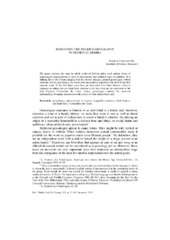Приказ основних података о документу
Imagining the Ruler's Genealogy in Medieval Serbia
| dc.creator | Vasiljević, Marija | |
| dc.date.accessioned | 2019-06-22T05:38:55Z | |
| dc.date.available | 2019-06-22T05:38:55Z | |
| dc.date.issued | 2017 | |
| dc.identifier.issn | 0035-2063 | |
| dc.identifier.uri | http://revista.acadsudest.ro/Arhivă/Revista%202017/RESEE%2055%202017.pdf | |
| dc.identifier.uri | https://dais.sanu.ac.rs/123456789/6257 | |
| dc.description.abstract | Abstract: The paper explores the ways in which medieval Serbian rulers used various forms of genealogical representations in order to demonstrate their political status or ambition. It is striking that in all of them, ranging from the diverse lineages, painted genealogies, written monastic and lay genealogies, the rulers were unavoidably depicted as the heirs to the first dynastic saints. In the first three cases they are descended from Saint Simeon, either in company or without his son Saint Sava, whereas in the latter they are the successors of the holy Emperor Constantine the Great. Hence, genealogies embody the medieval epistemology of origins, understood as the source of value and political right. | en |
| dc.language.iso | en | sr |
| dc.relation | info:eu-repo/grantAgreement/MESTD/Basic Research (BR or ON)/177029/RS// | sr |
| dc.rights | openAccess | sr |
| dc.rights.uri | https://creativecommons.org/licenses/by/4.0/ | |
| dc.source | Revue des études sud-est européennes | sr |
| dc.subject | genealogies | sr |
| dc.subject | epistemology of origins | sr |
| dc.subject | imaginative memory | sr |
| dc.subject | Saint Simeon and Saint Sava | sr |
| dc.subject | Constantine the Great | sr |
| dc.title | Imagining the Ruler's Genealogy in Medieval Serbia | en |
| dc.type | article | sr |
| dc.rights.license | BY | sr |
| dcterms.abstract | Васиљевић, Марија; | |
| dc.citation.spage | 73 | |
| dc.citation.epage | 88 | |
| dc.citation.issue | 55 | |
| dc.type.version | publishedVersion | sr |
| dc.identifier.fulltext | https://dais.sanu.ac.rs/bitstream/id/19611/bitstream_19611.pdf | |
| dc.identifier.rcub | https://hdl.handle.net/21.15107/rcub_dais_6257 |

